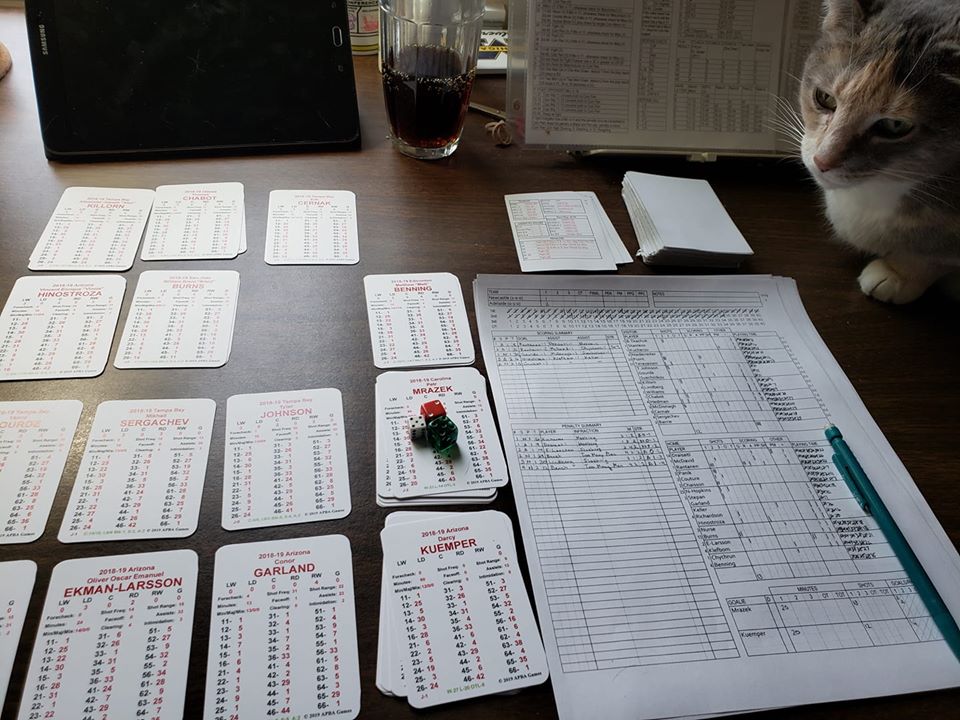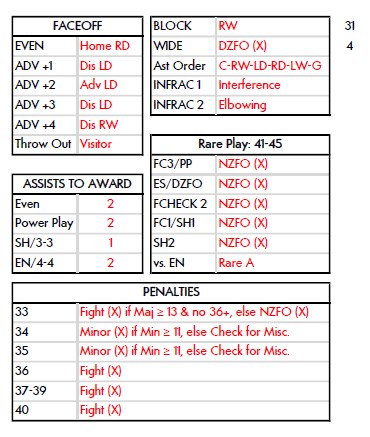I had posted a picture of my cat on the APBA Games Facebook group watching me play a hockey game. Nobody commented on who the team were or that I’m insane enough to capture time played. However, a couple eagle-eyed posters noted a stack of cards that looked different.

Am I daring to play an APBA with something other the two standard dice? Well, yes, I do regularly commit APBA blasphemy. Ignore the third die for now, we’ll cover that in another post.
For those who have played the APBA Soccer game, you may have an accessory known as a fast action deck. This essentially combines a dice roll with a board read, a time saver for those especially for those hard to memorize plays. This is basically the same concept, but for hockey. Here is an example card:

There is one card for each of the possible 36 dice combinations. On each card are the results for that dice roll for a few of the more common board lookups. Note that in the case of some of the items, they’re modified a bit from the regular boards because I have found them to be more accurate. In a typical game I usually use about 1 1/2 decks.
How to use the card
- Faceoffs are pretty self-explanatory, and match exactly what is on the board.
- The assists are actually in two spots. On the left is the number of assists to award depending on the situation, while on the right is the order to determine who gets assists in the same manner you would do in the regular game. The reason for the split in situation is that the number of assists awarded tend to be situation-dependent (more on power plays, less on shorthanded, for example.)
- Block and Wide work the same as the boards.
- INFRAC1 and INFRAC2 are not found in the game. If you get a minor penalty, use the INFRAC1 value for what the penalty type is. If it says ‘INFRAC2’, flip to the next card and use the value under INFRAC2. Occasionally the value will be dependent on the position of the penalized player, and is denoted by F or D.
- The rare play portion works pretty much like the regular boards, except which number was called is not important, just that a play result of 41-45 was hit. ‘Rare A’ refers to the first column of the rare play chart, ‘Rare B’ the second, and so forth. Also appearing could be a bench minor (so no need to double-check for that) or the incredibly rare goalie shot.
- The penalty grid at the bottom of the card don’t match the game exactly, rather they remove some of the situational-dependent penalties and make them more a random chance. Note that when conferring to determine a penalty:
- If shorthanded, use 33 instead of 34
- If two-men down, use 33 instead of 34 or 35
- If a 36-41 is used and a fight is indicated, use the following changes once you have determined the opponent:
- A reroll of 11-21 and an opponent Major rating of 11 converts both penalties to coincidental minors.
- A reroll of 22-32 and an opponent Major rating of 11 converts both penalties to coincidental minors.
- A reroll of 33-43 and an opponent Major rating of 11 converts both penalties to coincidental minors.
- A reroll of 44-54 and an opponent Major rating of 11 converts both penalties to coincidental minors.
- A reroll of 55-66 keeps the penalties as matching fighting majors.
This is all great, but don’t you want a copy of these? Well sure you can. Below is a link to a 4-page PDF that will have one set of 36 cards. I recommend printing two sets on to card stock, and cut them in ninths so they resemble a card deck. As mentioned earlier, you will likely use 1-2 decks per game.
GOOD STUFF once again
What are the black 2 numbers in the upper right hand corner of each FAC?
The actual dice roll that produces the card’s results.